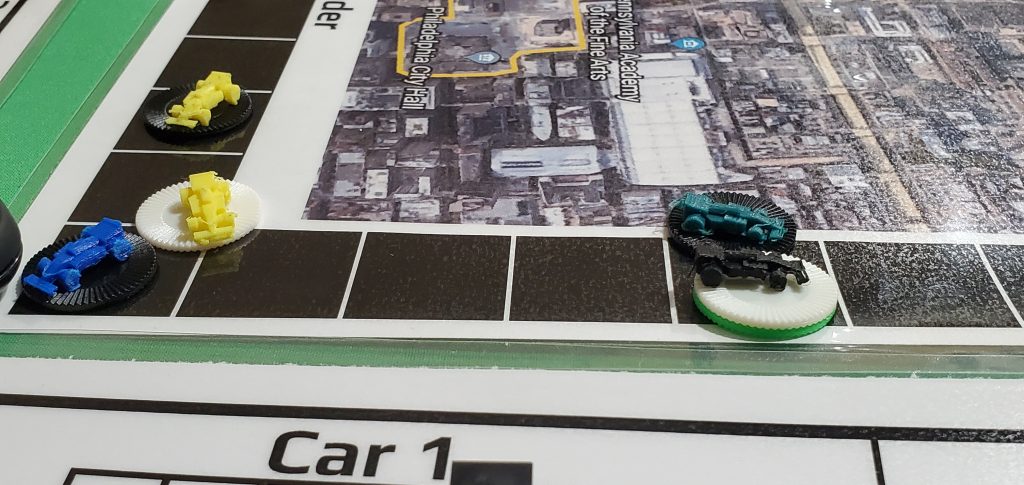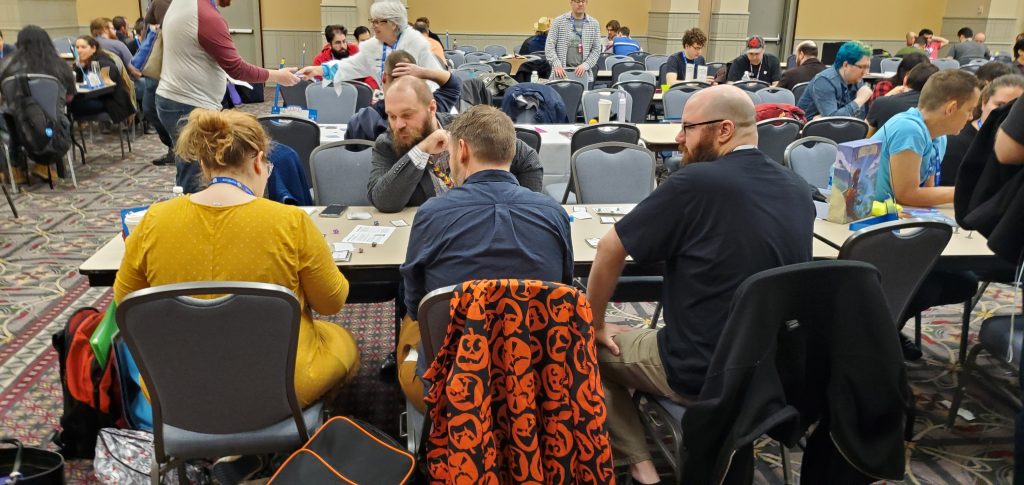I demoed a prototype of my game, Formula Grand Prix during the UnPub event at Pax Unplugged 2019.
Formula Grand Prix is a game that has been in my head for almost 3 decades. It’s something I make attempts to create from time to time around other designs, but I’d never gotten it to a table prior to the lead up to PAX. It always felt imperfect or lacking. Often it felt too big a game for me to design.
The concept for Formula Grand Prix came out of a single thought:
What if someone made a game that did for Formula 1 what Axis & Allies does for WW2?
Axis & Allies is a classic game first published in 1981 that puts players in control of one of five nations. Players are tasked with winning the war by capturing territory, producing units, and determining when and where to battle. It’s a very high-level view of WW2, with armies represented by tokens and chips and where conditions like weather, roads, and troop morale do not factor into the game at all. This creates an accessibility that other wargames often miss, even though the game length itself can exclude some players.
My vision for Formula Grand Prix grew from there. What would a game look like that captured the high-level strategy of an entire Grand Prix? As much as I love them, games like Formula D focus on the decisions of a driver over a single lap, but the kind of strategy that comes from tens of laps at the team level isn’t present.
The biggest omission is the pit stop and the strategy surrounding it. Grands Prix are won and lost in the pits. A slow tire change or a well-timed undercut to get into a clear part of the track and turn out quick laps can turn the race in the favor of a team willing to take a risk. What I found missing from racing games were these types of decisions – ones not made based on a specific round of the game, but as a reaction to the actions of another player.
I settled on a design for the board that features spaces along the outside edge of the board to represent the distance in time between cars. Each space was roughly a second, and each round of player turns would serve as a lap. I wanted to streamline player actions and decisions so that players could take 20 turns in a game that would take around 90 minutes.

Each player controls a team of two cars. These are represented by Grand Prix car miniatures. I then used the Axis & Allies-style mini gaming chips under the miniature show statuses, such as the lead car, lapped cars, and damage (though not enough of these chips arrived before PAX). Each car would use energy, suffer tire wear, and take damage, all of which would get tracked on the player board.
Players would then choose how fast their driver would go for that lap. A driver instructed to push would use more energy and more of their tires in exchange for a faster lap (more spaces traveled on the Time Track). A driver instructed to drive conservatively would save more of their energy and more of their tires which would result in a slower lap.
To make things matter even more, two cars ending their movements on the same space must Battle For Position – a mechanic that creates a mini battle within the main game. Players face off, rolling dice and committing to a driving style (which would cost them more tires and energy), with the winner getting the position (but only advancing a single space ahead). Traffic then plays a big role in the progress of the race – a car that pits for fresh tires and wants to push for several laps to get ahead of a rival could get stuck behind a car driving conservatively, or worse – could take damage to their car that would slow them until repaired.[
I had a very different game in mind for PAX. I’d been working on a superhero game for a few months, and I was closing in on a design I felt worked very well. I had one issue with it that I thought I could easily correct. A week before PAX I realized that this was not the case. The game was actually more broken than I had thought at a core level. I hadn’t noticed because no one had tried a very specific strategy, and when my playtest group did we noticed just how broken the game could become.
I was frustrated, and I had no idea exactly how to fix the issue. I still wanted to go to PAX and demo something, if just to get the experience of doing it. It was then that I decided to finally get Formula Grand Prix into a real, working form. There was something about having nothing to lose at all that made the decision that had felt so impossible previously so easy to do.
The physical game together for the first time two nights before PAX, with only two playtests before the show. There were a few issues, places where I’d have wanted to improve components or adjust rules, but there wasn’t time for that. The design that I had was what I had to take. I was quite nervous, even after the playtesting, that the entire thing would not be viable or interesting to others.

On the day, I found many games with full art and well-tested designs. Still, A handful of brave souls found their way over and tried out the game. The feedback was excellent, and the game was not a broken mess as I had feared. There are changes needed, refinements to be made, and more tests to complete, but UnPub at PAX was an important step in the evolution of Formula Grand Prix.
